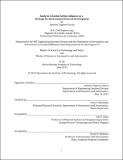Analysis of global airline alliances as a strategy for international network development
Author(s)
Tugores-García, Antonio, S.M. Massachusetts Institute of Technology
DownloadFull printable version (3.380Mb)
Other Contributors
Massachusetts Institute of Technology. Dept. of Aeronautics and Astronautics.
Advisor
Peter P. Belobaba.
Terms of use
Metadata
Show full item recordAbstract
Since the late 1990s, network airlines worldwide have being enrolling in one of the three current Global Airline Alliances (GALs), oneworld, Star Alliance and SkyTeam. By 2011, airlines belonging to the three GALs transported over two-thirds of all international traffic. This thesis studies the reasons that cause an increasing number of airlines to join this collaborative scheme as a way to develop a wider network and to increase profitability by serving international connecting traffic. The evolution of GALs is characterized here by the analysis of the size of these alliances, as well as by the volume of partnerships and code share agreements between alliance partners during the period 2006-2011. The results of this study illustrate the differences between each of the GALs and the degree of dependence of airlines on alliances to develop their international networks. By most indicators, the largest alliance, Star Alliance, is the GAL in which member airlines rely more on their alliance partners when developing code share agreements with foreign airlines. In all three GALs, code share agreements between alliance partners are much less likely to be broken than with nonpartner airlines. Airlines operating in the transatlantic markets appear to be the most advanced firms in the marketing of code shared itineraries. The empirical analysis is complemented with a review of the theoretical benefits of GALs to airlines, alternative network models for international growth, the impact of alliances on customers' welfare, their potential anti-competitive effects on independent carriers, and the current regulatory framework affecting alliances on both sides of the North Atlantic. Overall, this work provides a holistic view of the GALs as a model for network development, to describe their policy implications, and to suggest key drivers in the future of airlines' network development strategies.
Description
Thesis (S.M. in Technology and Policy)--Massachusetts Institute of Technology, Engineering Systems Division, Technology and Policy Program; and, (S.M.)--Massachusetts Institute of Technology, Dept. of Aeronautics and Astronautics, 2012. This electronic version was submitted by the student author. The certified thesis is available in the Institute Archives and Special Collections. Cataloged from student submitted PDF version of thesis. Includes bibliographical references (p. 117-126).
Date issued
2012Department
Massachusetts Institute of Technology. Department of Aeronautics and Astronautics; Massachusetts Institute of Technology. Engineering Systems Division; Technology and Policy ProgramPublisher
Massachusetts Institute of Technology
Keywords
Engineering Systems Division., Technology and Policy Program., Aeronautics and Astronautics.